What’s Inside:
















A look into the district’s approach to lockdown drills
The B asked students and staff to reflect on their personal sense of safety on campus in an anonymous survey.
This is what they said:
“Our community can be deemed safe. However, every single community that has had a school shooting says that.”
“No school in the US is completely safe.”
“I’m on the lookout everywhere I go.”
In the wake of the recent school shooting at Apalachee High School in Georgia, our staff sought to explore a question that’s becoming increasingly urgent across the nation: How prepared is our school for an emergency?
Over several weeks, we polled 100 students and 50 staff and interviewed 14 administrators, teachers, security experts, and students to piece together a comprehensive understanding of Burlingame’s safety protocols.
Burlingame hasn’t simulated Lockdown/Barricade drills since 2018, according to an email from former Assistant Principal Michele Fichera. The

BY CONNIE LU Web Editor BY SOPHIA BELLA Editor-in-Chief BY ZACHARY NEWMAN Managing Editor

decision was rooted in guidance from the San Mateo County Office of Education (SMCOE), which advised schools to move away from more traditional active shooter simulations due to concerns about their psychological impact on students.
According to SMCOE School Safety and Risk Prevention Coordinator Mason Henricks, the county cited research from Everytown for Gun Safety, a nonprofit advocating against gun violence, which linked active shooter drills to increased rates of “depression, stress, and anxiety” in “high schoolers, their parents, and teachers.”
Instead, SMCOE urged schools within the San Mateo Union High School District (SMUHSD) to adopt a more “trauma-informed” approach,
emphasizing awareness, decision-making, and the ability to “think on your feet” over high-intensity simulations.
“We follow a more trauma-informed approach, teaching students how to think on their feet and be aware of their surroundings, to make decisions, to either escape and get off campus, hide, lock down barricade or protect and defend themselves,” Henricks said.
Burlingame adopted this approach in alignment with the county’s recommendations.
“We realized that it was more harmful than helpful to practice [simulated Lockdown/Barricade drills],” Principal Jen Fong said.
SMUHSD Director of Student Services Don Scatena said performing Lockdown/Barricade drills are not
worth trauma risks.
“Statistically speaking, you’re going to be potentially far more likely to have triggered students as opposed to an actual act of violence,” Scatena said.
Despite the potential trauma Lockdown/Barricade drills can cause, 57% of student respondents agree that simulated Lockdown/Barricade drills would help them feel safer, with 27% feeling unsure, according to an anonymous survey conducted by The B. Freshman Ezra Bartlett Ambrose argues practicing drills reduces trauma rather than creating it.
“Compared to the trauma that someone will face if there’s a school shooter and let’s say you or a friend is
See “LOCKDOWN,” page 3
BY INY LI Business Manager
BY AUDREY WEI Senior Reporter
Moving from Taiwan was already a challenge for sophomore Brandon Lin, who enrolled at Burlingame with limited English proficiency. Over the past two years, Lin has juggled seven courses alongside native English speakers, but found steady support through his Community Literacy in Action (CLA) class, which serves multilingual students at all English proficiency levels.
The CLA class and English Language Development (ELD) classes form the core of San Mateo Union High School District’s (SMUHSD) multilingual support system, helping almost 1,000 students build the skills needed to succeed in their coursework.
Lin, whose school in Taiwan was primarily assessment-based, said the CLA class offers practical speaking, listening, reading, and writing skills.
But in October 2023, the California Department of Education’s Federal Program Monitoring (FPM) compliance review determined that SMUHSD was not meeting the provisions of Title I and Title III, which support low-income and multilingual students.
The review found that SMUHSD’s multilingual program limited school choice for multilingual students and their families. Until last year, ELD classes were only concentrated at Hillsdale, San Mateo, and
Capuchino High School, plus the Bridge Academy, an external multilingual program, said SMUHSD Director of Curriculum and Assessment Brian Simmons. But to comply with state requirements, SMUHSD integrated multilingual students districtwide in spring of 2024, moving those in ELD programs for over three years into college-preparatory classes.
“We now need to provide much more support to our teachers because we now have a much more diverse student population at every school in the district — but certainly at Burlingame in particular — because the population of multilingual learners there has always been pretty small,” Simmons said.
Despite expanding CLA and ELD programs, Kelly Hensley, a longtime multilingual program teacher, describes the challenges that come with integrating these students at Burlingame.
“We need to create more awareness of identifying the multilingual students in mainstream classes and giving teachers ideas on how they can better accommodate these students and help them understand the curriculum,” Hensley said.
Assistant Principal Valerie Arbizu said a key challenge is placing multilingual students with their age group while addressing language barriers that can make it difficult to connect with peers and teachers.
“I think that’s when our teachers get frustrated, because they see how frustrated the stu-

dents are, and it comes from a place of, ‘how do I support my students?’ ” Arbizu said. “When you don’t know the answer, it makes you feel bad [and] disconnected.”
Government teacher Alex Gray emphasizes the difficulty of dividing her time between native English-speaking students and multilingual learners in the same classroom.
“In a perfect world, I’d have way more time to sit with [multilingual learners] and go over it in a slower manner and print more resources [for them],” Gray said.
In Hensley’s ELD 3 class, he focuses on preparing newcomer students for the English Language Proficiency Assessments for California (ELPAC) test by catering to their individual needs and creating a supportive learning environment.
For ELD 3 students like ju-
nior Frankie Jiang, who moved from China midway through his freshman year, keeping up with the core curriculum alongside native English speakers has been a struggle. Despite this, Jiang highlights his mainstream teachers’ efforts to accommodate his needs.
“I get to use translators during my essays in English class, and I have both the English and Mandarin versions of The Great Gatsby,” Jiang said. “And when I was in sophomore year, Mr. Dyl was my chemistry teacher, and since I told him I couldn’t understand the free response and multiple-choice tests, he provided me with a Mandarin translation so it’s easier for me to understand, and I still do that for AP Chemistry this year.”
As the district continues collaborating with educators, it aims to expand its multilin-
gual programs by equipping faculty with adaptable resources through translation tools, targeted professional development, and Universal Design for Learning (UDL) training. Simmons highlights the district’s commitment to fostering a more inclusive approach.
“Too often we talk about these students from a deficit perspective, and so we as educators are trying to shift this into ‘What are these multilingual students bringing?’” Simmons said. “Our immigrant students are bringing interesting, complex stories about their personal journeys that brought them here and where they came from, so the more we can keep promoting and supporting this as an effort to create a more democratic space in our classrooms and schools, I think the better off we’ll be.”

From pg. 1
injured … That’s going to be way more traumatic than just a simulation that you know was a simulation,” Ambrose said.
Because Burlingame no longer performs these drills, chemistry teacher Joshua Dyl noticed emergency guidelines for staff have become less “concrete,” instead prioritizing flexible real-time procedures for staff.
“It seems like [years] ago, it was like, ‘here’s the plan, here’s what we do in the case of an emergency,’” Dyl said. “In recent years, that’s now shifted from being absolutely concrete to being in the moment, ‘you got to do what you think is safest.’”
The Big Five: ‘a coordinated response’
Burlingame’s training approach aligns with the county’s broader procedures under the Big Five emergency response plan, developed in 2014 by San Mateo County’s Coalition for Safe Schools and Communities. The plan outlines protocols for Lockdown/Barricade, Shelter in Place, Drop Cover and Hold On, Secure Campus, and Evacuation. While SMCOE cannot enforce these policies, all 23 public school districts in the county have adopted them, said Henricks.
46%
During the dual Great ShakeOut drill and Big Five emergency training on Oct. 17, Burlingame saw the county’s recommended “trauma-informed” approach put into practice. Assistant Principal Aimee Malcolm led a two-part, 15-minute webinar to instruct students and staff on all five emergency responses. The other 15 minutes were dedicated to simulating
drills for Secure Campus, Evacuation, and Drop, Cover and Hold On.
Staff emphasize the ‘need to practice’
Malcolm said the administration prioritizes training staff to respond effectively in emergencies.
“We give an overview [of Lockdown/ Barricade drills] at the beginning of the year, then on September 18, we went over it again,” Malcolm said.
Malcolm said another Lockdown/ Barricade training session for staff will occur on Nov. 15. The upcoming training will avoid simulated active shooter drills and instead focus on ensuring staff understand their roles in executing lockdown protocols.
According to Burlingame Police Department (BPD) School Resource Officer Jarrod Burkholder, in addition to staff training, BPD also has “active shooter training” on campus while students and staff are on break so that officers are “well-versed in the layout.”
Because students don’t participate in training with BPD, the responsibility for effectively executing Lockdown/ Barricade procedures rests largely with staff.
of surveyed staff think about the possibility of a school threat on campus once a month
“We do a fair amount of training with the staff,” Fong said. “If we were to announce lockdown barricade, we expect the staff to be able to, within seconds, effectively, lock down your doors.”
Despite this expectation, 54% of surveyed staff believe they receive sufficient preparation to respond to potential school threats.
“In my experience, nobody seems to know what to do in [the] event of
a school shooting,” one teacher wrote. “There’s a lot of vague and contradictory information out there.”
Another teacher said staff should drill specific Lockdown/Barricade procedures.
“We should practice locking our doors in an efficient manner, windows, covering them up, etc. We used to practice all that,” a teacher wrote. “If someone walks through our front doors with a gun, we are all dead. There is nothing to stop them.”
these concerns: 59% of surveyed students report thinking about a school threat at least once a month.
“It’s disgusting and cruel to students to have to deal with the normalization of mass student killings… That’s not normal…You [should] get to enjoy your youth, rather than having to fear for your [future],” sophomore Simon Jerus said.
of surveyed students would feel safer if BHS had lockdown drills 57%
Although 78% of students and staff report feeling safe at school, concerns about potential intruders remain.
Campus security: ‘Anyone can walk in’
The numerous points of entry and lack of a physical barrier have raised concerns about outside access to school grounds. Although Burlingame has a closed campus policy, 42% of student respondents reported encountering strangers during school hours. Senior Marco Sodini experienced this first-hand.
“The thing that icks me out is that we have such an open campus anyone can walk in,” Sodini said. “I’m going to the bathroom during class and then I see a lady walking her dog through the quad.”
The presence of trespassers adds to staff apprehension. 74% of staff surveyed think about the possibility of a school threat at least once a month, while 14% surveyed think about it daily.
“The question is, if there is a school shooting, what will the District say they did to prevent it? The answer is nothing really... there are no deterrents around our school to prevent someone from walking in and shooting the place up,” a teacher wrote.
Staff aren’t the only ones who share
“The Burlingame community is great, but all it takes is one person to cause havoc,” a teacher wrote.
One proposed solution is building a fence. According to Fong, the idea has been discussed but deemed unfeasible due to aesthetics, cost, and community backlash.
Campus Safety Specialist Ernesto Nuñez said a fence would create designated entrances and exits.
“I think it would help us do our job even better,” Nuñez said.
‘A culture in which school shootings are a reality’
As schools across the nation navigate strategies to enhance security, the looming threat of violence remains a persistent and unsettling reality.
“In our current climate, schools have become targets for, what seems like, random violence,” a teacher wrote. “This fear is only compounded when our campus feels so open where anyone can walk on at any time. We carry on with our days like normal but there is always this idea, this fear that feels almost inevitable, in the back of our minds.”
BY NATALIE GYDE Multimedia Editor
As electric bikes become more popular in Burlingame, concerns about pedestrian and cyclist safety are prompting the city to explore new regulations for high-speed e-bikes.
quite a few close calls — in particular in Washington Park between either dogs, seniors, or children and e-bikes that were zipping through the park,” Glomstad said.
California law divides e-bikes into three classes: Class 1 provides motor assistance only while pedaling, capped at 20 mph; Class 2 includes pedal-assist and throttle, also capped at 20 mph; and Class 3 allows speeds up to 28 mph.

like Washington Park and Burlingame Avenue saw a rise in complaints from concerned citizens, according to Parks and Recreation Director Margaret Glomstad, who noted increasing issues with youth and reckless e-bike riding.
“There’s been concern about youth riding bikes without helmets or not obeying the traffic laws, and there were
With these distinctions, the Burlingame City Council has been navigating the complexities of e-bike regulation. Initially, they imposed restrictions on e-bikes in all public areas where pedestrians walk, including the Bay Trail. However, after feedback from the biking community, the council revised the limits to apply only to public parks, exempting the Bay Trail.
Burlingame Council member Michael Brownrigg highlights the importance of public opinion in shaping safety policies for youth on e-bikes.
“Our police chief has been starting to meet with school officials [to] try to encourage young people to understand that if you hit something, you could kill yourself, so this is an education campaign,” Brownrigg said.
According to a public comment during the city council meeting, over the past dozen years in San Mateo County, 12 people have died, and roughly 1,277 have been injured, with 24% involving cyclists, excluding close calls that go unreported. Burlingame already has

laws in place to ensure safety in public parks, like Burlingame Municipal Code 13.52.180, which requires riders to yield to pedestrians and follow all park rules and posted signage. However, Washington Park lacks posted speed limit signs at its entrances.
“I definitely think we need to do a better job with signage. The real ity is that our rules did not address e-bikes and parks. In other words, because we didn’t address it, the understanding is you’re al lowed to do it,” Brownrigg said.
Freshman August Evans expressed concerns that e-bikes are often unfairly blamed for accidents, with the community focusing more
on banning them rather than emphasizing safety education and road rules.

“I think [accidents] are kind of a major thing. I don’t want anything to happen to me, so I always make sure I can stay safe,” Evans said. “I feel like kids on e-bikes aren’t responsible for a whole lot of accidents, I feel like those very few cases get really highlighted.” Evans and freshman Jackson Audant, who both use their e-bikes as daily modes of transportation, said that potential restrictions would significantly impact their day-to-day mobility.
“I think [e-bikes] have become a big part of our lives. Taking them away would just make our lives harder,” Audant said.

BY AKIRA NAKAMURA Staff Reporter

The task of cooking for 1,500 students has undoubtedly become more challenging after the school cafeteria introduced preparing meals from scratch at the end of the 202223 school year. Rather than reheating pre-packaged meals, the cafeteria is turning to homecooked meals using their own original recipes.
“We make all of our fries except tater tots — we get fresh potatoes, we wash them, we cut them up, and we bake them,“ San Mateo Union High School District Director of
Nutrition Denis Vorrises said.
Beyond improved taste, the school switched to cooking from scratch to prioritize better nutrition. Using fresh ingredients allows cafe teria staff to reduce some unhealthy components that couldn’t be altered with pre-packaged meals.
“We are not supposed to put sugar and salt in the recipe, so that makes [the food] very healthy,” Lead Kitchen Manager Siu Yuen said.
To comply with strict state nu tritional guidelines — which limit school meals to under 850 calories, 1,420 mg of sodium, and 0 grams of trans fat — the kitchen staff has re duced portion sizes.
“To meet the less salt, to meet the less fat, and to meet the calories … portion sizes end up being small er,” Vorrises said.
— we encourage that. Unfortunately [the students] don’t always grab it,” Vorrises said.
Freshman Jason Lu, however, finds the variety helps him balance his plate.
“I sometimes grab apples, they have a lot of options for me to choose from and that makes it a healthy
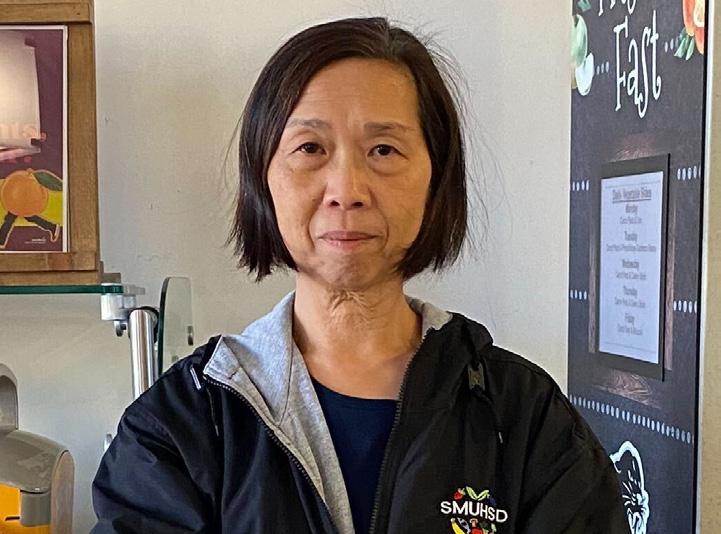

The cafeteria encourages students to add fruits and vegetables to their meals, but not all students take advantage of the options.
“They can grab four pieces of fruit
crease the diversity of meals on the menu.
“I would like to bring more new recipes so that the kids don’t feel that [they are eating] the same items. That is my main goal,” Yuen said.
With the recent retirement of former lead kitchen manager Vicki Ottoboni, new Lead Kitchen Manager Siu Yuen is ready to impress the growing number of students eating school lunches with
Yuen has been creating a variety of meals for many years, and her passion for
“As a mother, I really like to cook food for my kids. I create a lot of Asian food, American food, Korean Food, and Japanese food at my home. So I would like to share my experience in our school
Yuen began her professional cooking career 12 years ago while supervising a
“I [was] working in a bakery as a manager for two years, and then I was working in Panda Express for a year and then in this district [for] nine years,”
This experience has helped her to manage the difficult task of overseeing a
“I start at 5 a.m. in the morning and then [prepare] our food. So in the first two hours, I’m preparing brunch, breakfast items, so yogurt, cinnamon bun, french toast, and muffins,” Yuen said.
BY CONNOR LEONG Staff Reporter
From Canvas to Chromebooks, technology has become a fixture inside the classroom.
The impact of the pandemic, which forced educators to rely almost solely on digital tools for instruction, still lingers. However, now that students have returned to in-person learning, some may wonder
whether sole reliance on computers is still necessary for effective learning.
Although world history teacher Jim Chin allows his students to choose between taking notes on paper or online, he acknowledges that many may struggle to stay focused when using computers.
“I noticed I learned more when I was taking notes by hand [in college] …

I wouldn’t be distracted by having access to the internet,” Chin said. “I think a lot of students will probably have some similar temptations.”
Yet, sophomore Izzy Erickson chooses to take handwritten notes in Chin’s class for a different reason: she finds that writing by hand helps her remember the material more effectively.
“Even if I don’t review [my notes] ... writing it instead of typing it helps me retain the information,” Erickson said.
Others believe technology boosts productivity. While sophomore Rishabh Purwar recognizes the possible drawbacks, he feels computers can be beneficial if used productively.
“I can say [that] almost everyone has struggled to stay on task [on a computer], but that’s the trade-off you have of getting technology to make things more easy for you,” Purwar said. “I think it’s definitely still more worth it if we can get ourselves to
work better on it.”
For Chin, digital tools have streamlined parts of his work, allowing him to efficiently catch mistakes and spot trends in student performance.
“It’s [now] really easy for me to tell if a [multiple choice] question was really janky or I accidentally made two answer choices correct. Canvas will just show me that whereas back when the things were bubbled in Scantron, I would have to feed [them] through a machine and then get that data,” Chin said.
Despite the convenience technology may bring, English teacher Amy Farley said that computers are a distraction, noting the negative impact they have not only on learning but also on interactions between students.
“A lot of times when students have their devices out, even if we’re doing something collaboratively, it’s easier for them to step aside to their math homework or their online shopping for prom or whatever else is happening,” Farley said.
Freshman Will Mullen-Weaver believes that computers can be helpful for organization, but can, in excess, be unhealthy for students.
“I feel like working electronically could be more organized because you don’t need to keep track of paper. But also, kids spending time on their computers for every class might [not be] good for them… paper might be a little bit healthier,” Mullen-Weaver said.
In addition to health concerns, Farley adds that newer technologies like generative artificial intelligence can encourage academic dishonesty, prompting her and some of her colleagues in the English department to shift toward primarily paper-based classrooms.
“Overall, it’s an interesting moment we are in … I really value technology as a whole. I think the difficulty is we’ve sort of let all this power out, freely available, which is wonderful in an equity sense, but makes it very hard,” Farley said.
BY ALEX BERTELLI Senior Reporter
Following a 2021 decision, Burlingame adopted a ‘by-district’ system to elect city council members. In the previous ‘at-large’ system, residents cast votes for all council seats. In the by-district system, Burlingame is split into five areas that each elect one representative. Districts 1, 3, and 5 are up for reelection every four years after 2022; districts 2 and 4 cycle every four years starting 2024. This election, a seventh candidate, Andrea Pappajohn, is on the ballot for an unopposed partial term in district 1. Burlingame moved from at-large elections because of a letter sent in 2020 from attorney Kevin Shenkman claiming it infringed on the California Voting Rights Act of 2001. Though elections happen by district, council members act for all of Burlingame. The title of ‘mayor’ falls based on seniority to the person who has been in city council the longest.

El Camino Real construction
Enhancing road safety, usability, and visibility

improve safety and accessibility

District 2 candidate
Throughout her career, Nirmala Bandrapalli has learned the importance of both speaking up and listening. Bandrapalli’s first leadership experience was serving as the president of her college in India, where she engaged with local leaders and “learned how to speak up and get things done.” She immigrated to America to pursue higher education, getting a Master’s degree in Biochemistry and entering the healthcare industry.
Since then, Bandrapalli has put decades of work into community service and project management for Burlingame. Her initiatives included serving on Burlingame’s Planning Commission, working with local schools, and helping make streets safer.
“I have 25 years of work experience, the skills in managing finances, collaborating, making decisions in the best interest of the public,” Bandrapalli said. “All of those things motivated me to be a voice for everyone who doesn’t have a voice, and [to bring] a diverse perspective [to] the council.”


RACHEL NI
District 2 candidate
As a long-time Bay Area resident and real estate broker, Rachel Ni finds a special joy in helping people secure their dream homes.
Ni found her home in the Bay Area. After moving from Taiwan in 2002, she worked for over a decade as a hotel manager. Her shift to working in real estate helped her to achieve her decades-long goal of acquiring permanent housing in Burlingame. Since then, she has helped others do the same as both an agent and a member of local housing groups making Burlingame an ever-appealing place to live.
Ni plans to prioritize issues related to housing, public safety, and business-friendly initiatives. As someone whose family is deeply rooted in Burlingame, she is dedicated to supporting others and giving back to the community.
“I love working with people. I became a real estate broker, which … is all about collaboration and management. … I just have a passion for helping our local businesses, helping the seniors, [the] youth — that’s the reason I’m doing what I do today,” Ni said.


District 2 candidate
As a scientist, science educator, and long-time contributor to community affairs, Desiree Thayer is dedicated to creating a “vibrant, safe, and inclusive Burlingame.”
After moving to the Bay Area in 2006, Thayer acquired a PhD in biochemistry and entered the biotech industry. Over the past decade, while working as a researcher and chemistry instructor, Thayer became more involved in community efforts. She currently serves on a variety of county-level committees, working to improve legislation and promote civic engagement.
Thayer’s priorities for Burlingame include expanding affordable housing, public transit, safe streets, and local businesses. Her experience as a scientist helps her analyze issues and explain them to the public and also provides a curiosity-fueled drive for improvement.
“[Being] a scientist [has] kind of shaped me to be very data-driven. I want to hear from the residents and businesses — from everyone — hear their voices and how they feel on something. But whenever possible, I want to see the data too,” Thayer said.
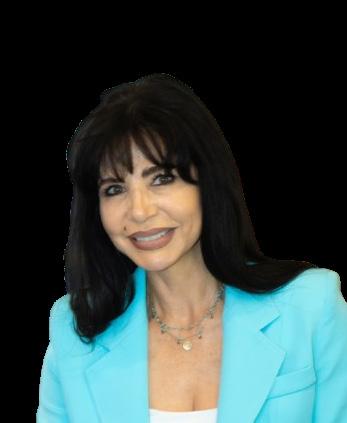

HADIA KHOURY District 2 candidate
Burlingame’s current Beautification Commissioner, Hadia Khoury, believes in making the local community a safe, clean, and attractive place for everyone.
Khoury has lived in Burlingame for 10 years and has owned a local skin care business for 25. As part of her work on Burlingame’s Beautification Committee, she helped install Christmas tree lighting along Burlingame Avenue and decorated the fronts of restaurants like Crepevine and Mykonos.
Khoury has an eye for small details but is also aware of the broader issues that need to be addressed in Burlingame.
“I was liaison between the Downtown Improvement District and the Economic Development subcommittee,” Khoury said. “I’ve attended every [city council] meeting for the last two years … and I was able to see what the city needs help with.”
Some of her priorities include improving El Camino, renovating Broadway and the Bayfront, and generally making “Burlingame as safe as it can be for pedestrians, drivers and cyclists.”

DONNA COLSON
District 4 candidate

As the current mayor of Burlingame, a city council member since 2015, and chair for both Peninsula Clean Energy and San Mateo’s Housing and Community Development Committee, Colson brings extensive leadership experience to the table. Colson’s relationship with Burlingame is one of “admiration and love.” She has been a resident for over 28 years, and her two daughters attended Burlingame public schools. Her previous professional experience includes 25 years as an investment manager and over a decade in government. Colson wishes to use her connections and strong relationship with Burlingame to “deliver results with fiscal stewardship and innovation.”
“I think bringing together the knowledge that [I] have about the staff [and] the leverage that I now have from sitting as the board chair for committees throughout San Mateo County allows me to bring in money and drive projects over the finish line, and that is really hard to do as a brand new council person,” Colson said.
TONY PAUL
District 4 candidate


Tony Paul is the Senior Transportation Engineer for Caltrans and a civil engineer of 26 years who aims to make Burlingame a more “prosperous and sustainable community.”
Paul sees similarities between his plans for Burlingame and his childhood experiences. When he was an adolescent, he struggled with math and algebra. His mother, emphasizing the importance of those skills, helped reallocate funds within the family to get him a private tutor. Because of his mother’s help, he was able to go into civil engineering and acquire a master’s degree in structural and earthquake engineering from San Francisco State University. In the 25 years since then, he has served as a senior engineer on the Caltrans team and currently handles traffic complaints.
Paul wishes to care for Burlingame in the same way. Some of his top priorities include improving police-community relationships, expanding public transit, and making certain intersections safer.

BY WILL KRINER Copy Editor
On July 25, 2024, U.S. Senator Maria Cantwell spoke on the Senate Floor about the damage social media companies were inflicting on their users, especially children.
When she cited the dangerous effects that social media has inflicted on youth, and the copious amounts of revenue social media companies have generated from child-targeted advertising, the Senate overwhelmingly voted to advance two new bills to protect children online.
“Americans, including kids, are being tracked across the internet and every place they go with a
phone or mobile device,” Cantwell said during the hearing. “Social media companies are harvesting our children’s personal data and making billions of dollars a year through targeted ads.”
Five days later, the U.S. Senate passed the Kids Online Safety Act (KOSA) and the Children and Teens’ Online Privacy Protection Act (COPPA 2.0).
KOSA aims to safeguard children from online harm by mandating online platforms to activate the most restrictive settings for children by default and allowing them to opt out of algorithmic data collection. COPPA 2.0 extends these protections, banning social media companies from
In order to collect information about teens and tech safety, The Burlingame B polled over 100 students on questions regarding social media, technology, and policy restrictions.

collecting personal information from anyone under 17 without their explicit consent.
Senior Isaiah Palacios supports the passage of new teen safety laws, as he believes they help regulate the content children encounter on social media.
“I do feel like we need stricter laws to protect children from seeing things they shouldn’t see or look at,” Palacios said. “It’s just unethical to use an algorithm to see what people like in order to keep them hooked on your platform.”
Despite the new laws, some students have doubts about their effectiveness. The main concern is how easily users can bypass age
restrictions when creating social media accounts, as the application cannot verify the user’s accurate age.
“I think [the current social media regulations] are too easy to bypass,” senior Ryan Kindberg said. “Let’s say a kid isn’t seeing what they’re supposed to see on their Instagram page, they could just make another account. There’s always ways to get around [social media policies].”
Generational trends are another reason policymakers have struggled to enact online teen safety legislation. Lawmakers and young users view the dangers and prevalence of social media differently.
I think to myself ‘Should I really be [looking at social media] instead of getting work done?' I end up feeling like I should stop, but I don’t to be honest.”
- Ezra Bartlett Ambrose, freshman

Scrolling [on social media] takes a lot out of you, it makes you feel more tired and you generally are less productive."
- Alisa Leung, freshman



I had TikTok for a while, and I was losing sleep and missing assignments and homework because I was too addicted."
- Rohan Shah, junior

“There is a huge difference the way that adults know to stop, they’re more capable disconnecting and actually ting work done,” Palacios “Whereas, for children, it’s lucrative and it’s harder to disconnect because they’re ting drawn in.” Kindberg believes social companies should be doing work themselves to regulate line protection.
“The content on [social dia] is really in [social media forms’] control… It’s completely up to them, what shows what doesn’t, so I feel should be doing more,” Kindberg said.
On a scale of 1-5 (one being least, five most)...
Do you think tech companies do enough to protect users?

How dangerous in a general sense do you think media is?

How much do you trust social media companies?

you
media per day?



difference in know when capable of actually get-
Palacios said.
it’s more for them they’re getsocial media doing more regulate on-
[social memedia platcompletely shows up and like they Kindberg
BY JOSEPHINE WETTAN Copy Editor



Amid growing concerns about social media’s negative effects on teens, Instagram launched “Instagram Teen Accounts” on Sept. 17. These new accounts introduce several changes to the teen experience, including defaulting all accounts to private, implementing strict messaging restrictions, and adding a sleep mode. For users under 16, these settings can only be changed with the authorization of a parent or guardian.




To ensure age-appropriate content is shown to teens, accounts will automatically use the most restrictive setting for sensitive content control, limiting posts related to suggestive themes or suicide. However, these settings depend on teens accurately reporting their age. Instagram plans to increase age verification and develop technology to detect accounts operated by teens more effectively.

While TikTok has safeguards to protect teens, its safety protocols are less restrictive than Instagram’s.
Like Instagram, TikTok sets all minor accounts to private by default, but teens can change this setting. The platform also attempts to limit content for users under 18 on topics like disordered eating, body image, graphic content, and substance use. If users are banned by TikTok for being underage, they can appeal the decision with a variety of options to get their account back. Another part of the online experience is screen time reminders to help teens manage their app usage.
TikTok also utilizes a ”For You” page, which curates content based on an algorithm. This element, not as common on other platforms, makes it easier for teens' content to reach a wide audience.
For kids under the age of 13, YouTube has a dedicated YouTube Kids platform with tools that enable parents to supervise their child’s usage. For minors, YouTube’s main policies include strict content regulation in line with their community guidelines, covering content that encourages dangerous challenges, eating disorders, or the use of vulgar language. To watch age-restricted content, users must be logged in and over 18. Videos often have limited ad monetization criteria, which encourages creators to keep their content age-appropriate. According to Google’s Transparency Report, between April and June 2024, YouTube removed 5,046,178 videos for violating YouTube’s child safety policy, 163,000 for using hate speech, and 252,460 for showing violent extremism.
BY SOPHIA DOSS Copy Editor
According to a study conducted by Common Sense Media, nearly half of children in the U.S. receive their first smartphone by age 10, and over 90% of children own one by age 14, marking their entry into the digital world. Along with these devices comes access to social media, but many teens struggle to fully grasp its dangers, both initially and even years after joining these platforms.
As many teens use social media to document their day-to-day lives, it can foster unhealthy emotions, often leading to social isolation and detachment.
Wellness counselor Carolina Barraza said she sees this too often in teens.
“[Social media] can function as a way to numb ourselves after a stressful day along with it being addictive in nature,” Barraza said. “This then affects our responsibilities or even our self-care.
According to Barraza, teens who become reliant on social media to escape stressors may experience chang-

es in their overall demeanor.
“I think [that] there’s already mental health issues teens [are] struggling with like isolations and feelings of loneliness and low motivation,” Barraza said. “I think a lot of social media issues or usage can then increase those feelings and not be supportive with those issues.
One negative trait of many social media platforms is their permanence. Once a user posts something or interacts with a page, that engagement lives on the internet indefinitely. This has raised ethical concerns about big tech giants’ practices, something Burlingame National Association of Mental Illness (NAMI) club president Iny Li was quick to point out.
“There’s so many different elements about social media, especially the lack of restrictions that big tech companies have,” Li said. “It’s more about gaining profit and just gaining more attention to their platforms rather than protecting the kids and teenagers that are using [them].”
Beyond ethical concerns, social media has become a scary constant in

teens' lives, taking hours out of their days and becoming a primary way to connect with others.
Sophomore Kate Durfee navigated middle school and her first high school years without social media. While she could still successfully form relationships with her peers, she said she does view it as a disconnect.
“It definitely gets a bit awkward,” Durfee said. “Not having it makes it hard to keep up with my friends at times.”
Li has also seen social media’s effect on her peers personally, as it has begun to take over much of their lives.
“Doom scrolling, major doom scrolling. Our attention spans have been shortened so much,” Li said. “I have friends [where] whenever we’re studying, we have to put our phones in the middle of the table to ensure that we’re not constantly trying to check our latest notifications.”
Social media plays a pivotal role in teenage development, and with little to no effective guidelines in place, the protection and well-being of teens are in jeopardy.

BY KAI SHAH Staff Reporter
When senior Caitlyn Siu was just two months old, doctors diagnosed her with a rare disease that caused her liver to fail. Within months, she needed a transplant. The surgery came when she was 10 months old, but life since has meant continuing to battle immunocompromisation, which weakens her immune system.
Still, Siu is very grateful for her donor family as she’s fully aware of how many new names are added to the transplant list each day.
“There isn’t a day that goes by where I’m not thinking about [my donor family] or not reminded about them, and I feel like this is a really good time to … spread awareness to organ donation across our community and around the world,” Siu said.
Siu’s journey led her to the Transplant Games of America, a series of athletic competitions that advocate for organ donation and celebrate stories like hers. The games are open to organ recipients, donors, and family members. Sports are divided into divisions based on age and experience. At the event’s opening ceremony, participants share their stories.
“It’s also motivational, especially for a young person like me…to hear all these other
people and their stories there, and it’s also super important because it’s a big event that’s recognized. I feel like it should be recognized a little bit more because it just celebrates and brings awareness to organ donation,” Siu said.
Siu’s first year competing in the Transplant Games was during the pandemic. Competing virtually, she submitted her personal swim times online.
Compared to other competitors, Siu started swimming later in her life and felt that she was slower compared to her teammates, blaming her transplant. But the Transplant Games shifted Siu’s perspective, after she engaged with a community she learned from and related to.
“When I came back from my first Transplant Games…I wouldn’t excuse my poor performance for my transplant,” Siu said.
In 2022, the Transplant Games were held in San Diego, where Siu won 10 swimming medals. This past summer in Birmingham, Alabama, she earned 18 medals in both swimming and track. Siu also won the Team Cup with her teammates, awarded to the group with the most medals.
After the Transplant Games, Siu felt more encouraged to open up about her experience and engage with others who share a similar story.
“We realized that this is a

topic that not all people are aware of, so I feel like participating and always coming back and seeing all our friends and making sure that the celebration is heard, and spreading the awareness to organ donation is really important,” Siu said.
Beyond the thrills of competition, Siu loves the tightly-knit community she has found through the Transplant Games.
“I really love talking to the donor families because most of them are parents or siblings of a loved one, and you get to see how much love they still have for that person who unfortu-
nately passed away. And I like to hear from other recipients too…I get to hear a lot of their gratitude that we all share,” Siu said.
Siu plans to continue participating in the games, as they motivate her to stay healthy and reunite with friends. Most of all, Siu wants to raise awareness about the significance of organ transplantation and availability in the United States.
“I want everyone to know that I’m super grateful for the second chance of life and to take advantage of all the opportunities that come to you,
because someday I’m going to feel like an old person,” Siu said.
After every race, no matter the result, Siu said she remains thankful for the opportunity to compete.
“I think back about my donor. I wouldn’t be there competing without my donor. I wouldn’t be hearing about other people’s stories without my donor. So I always remember, I take a moment to remember my donor, and then when they do the medal ceremony, I always thank my organ donor whenever I receive the medals,” Siu said.
BY EVELYN DU Diversity Coordinator
Mysterious sweat stains, odd sizing, worn fabric on uniforms — this isn’t an ideal sight for anyone, but it’s the reality for girls’ varsity basketball. While not all Burlingame sports teams experience this problem, equipment and uniform disparities persist due to district funding constraints.
Senior Miranda Sibley, who plays three sports, is familiar with these discrepancies. She says flag football players receive new jerseys, and lacrosse players get new bags, sticks, and helmets, but the girls’ basketball team uses old, worn uniforms.
“Our flag football [uniforms] are very nice because they’re brand new,” Sibley said. “Basketball, I would say, are the worst uniforms that I’ve ever experienced. They’re really interesting[ly] fit and have a lot of stains on them.”
According to Athletic Director John Philipopoulos, the San Mateo Union High School District (SMUHSD) sets a uniform replacement timeline based on durability.
“At a minimum, we like to wait three years, but if we can stretch that into four or five that is even better,” Philipopoulos said.
SMUHSD also sets guidelines for the equipment they provide.
District-provided equipment — listed as “essential items” — includes uniforms, safety equipment, and other “necessary” gear for each sport. But coaches and players agree these items don’t cover all needs.
“I feel like [teams] receive adequate funding for the musthaves,” flag football coach Nicole Carter said. “There could be more funding for the extras ... like hurdles, [which] we are responsible for having to fund.”
The girls’ basketball team has worn the same uniforms for over three years. Although
the district funds essentials, Sibley says the team must pay out-of-pocket if they want new uniforms before the scheduled replacement timeline.
“Varsity has had the same ones since my freshman year, which is interesting because in all the other sports I have [played], we usually get new ones every two years,” Sibley said. “We had a lot of issues last year because we didn’t even have enough uniforms for everybody because of how many stained uniforms there were.”
Swimmers receive new suits annually. SMUHSD policy replaces district-provided equip-
ment every three to five years.
“We get new suits every year,” junior Catherine Kwong said. “They’re less sanitary to share with other swimmers year to year. I think that’s mostly… why we need new ones each year, compared to other sports that may have to reuse them.”
Burlingame’s cheer squad receives game uniforms and pompoms from the district but pays out-of-pocket for bows, practice gear, and jackets.
“It is pretty expensive since we’re paying for everything, so I think that the cost shouldn’t be as much, especially since we do [need] them all for the school
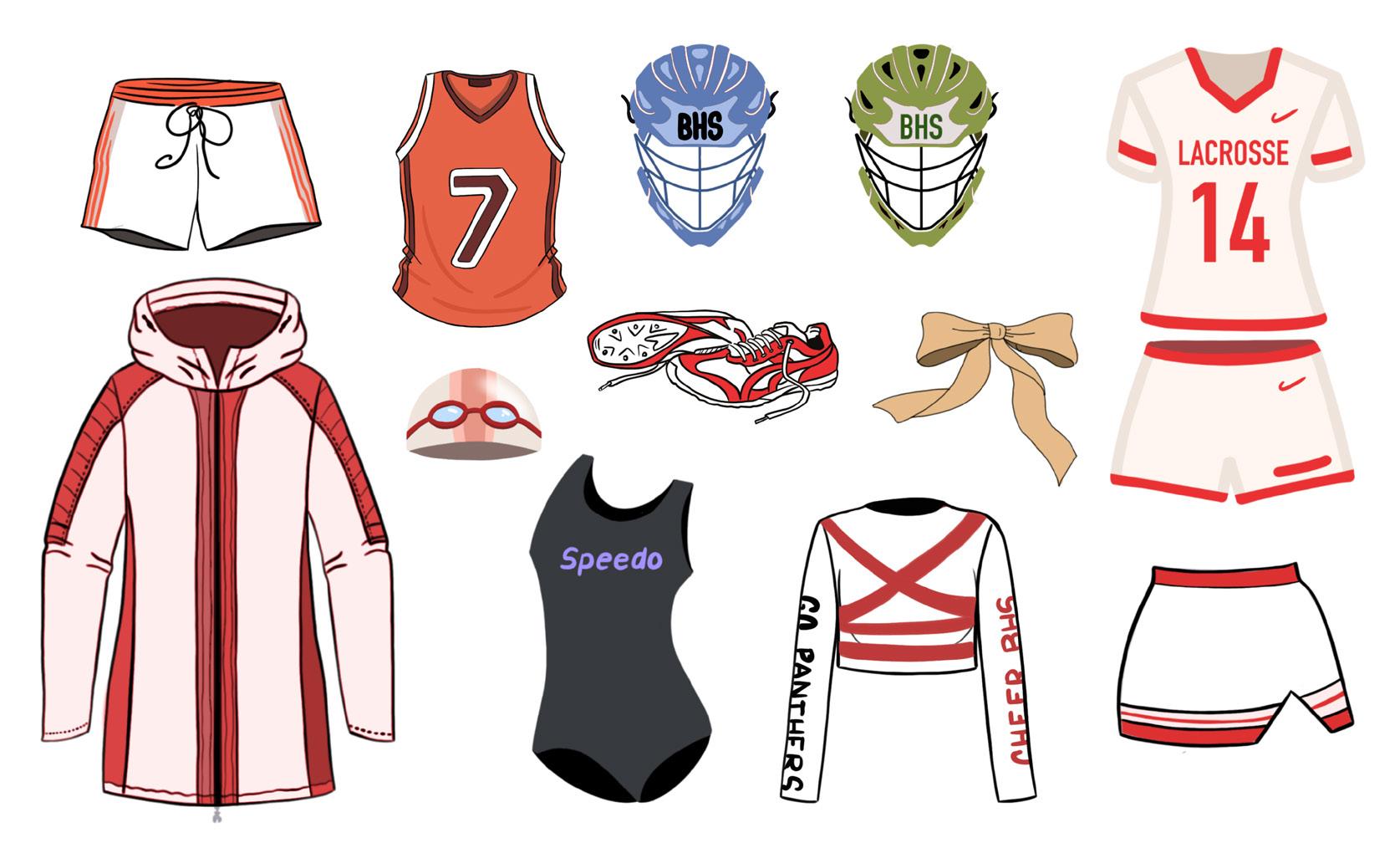
sport,” junior Maya Blouse said. According to Blouse, cheerleaders keep their gear but often need new practice items each year due to changing coach requirements.
The Burlingame Athletic Booster Club provides supplemental funding for freshmen teams and assistant coaches. Coaches can request non-district-funded equipment from boosters through a form.
“Every year, we get far more proposals than we’re capable of funding,” Booster Club president Andrew Alfers said. “Last year, we [increased] our initial allocation from about $3,000 to $15,000, [but] we received $40,000 worth of requests in total. We typically fund requests from coaches for safety-related items or equipment that we know will last a long time.”
However, fundraising success dictates equipment discrepancies.
“The [equipment] each team [gets] should be relatively the same per sport. Quality of the jerseys and how often they’re replaced, should [also] be the same and be more closely monitored by the district,” Sibley said. “[Playing in stained uniforms] feels like disrespect and lack of care. Like you’re at the bottom of the barrel and nobody’s looking out for you.”
BY HENRY GARDNER Head Photographer
Despite lower expectations coming into the season, varsity football has excelled this year as the current thirdplace team in the Peninsula Athletic League (PAL)
De Anza Division with a 2-1 league record as of Oct. 24. The offense is led by their rushing attack, which ranks first in the league. As the team’s primary ball carrier,
yards and seven touchdowns, four of which came in a 4317 blowout victory on Oct. 4. The Panthers have both a league title and a Central Coast Section (CCS) playoff berth in their sights. Senior linebacker Cole Hardtke is confident the squad can finish the regular season strong.
“We play with fire. We relentlessly [pursue] the football, and we got a nose for the ball, and we’ve been doing it all year,” Hardtke said.

5-2 record overall as of Oct. 24 and 2-1 in the De Anza Division.
212 total yards for senior running back Lucas Kirk

10-2
Peninsula Atheltic League (PAL)
Ocean record as of Oct. 23.
2nd place in the PAL Ocean Division tied with Hillsdale.
BY SOPHIA DOSS Copy Editor
Girls’ varsity water polo has rallied around each other this season—and it’s produced success. After a tough season with almost the same returning roster, the team has responded. Outstanding performances from junior Charlotte Guglielmi, and junior co-captains Aria Sherwood and senior Kelcey Flenniken have fueled their success this season. The Panthers’
dynamic turnaround is a testament to the unmistakable team bond. The squad owns a 10-2 PAL Ocean record as of Oct. 24 as the playoffs begin on Tuesday, Oct. 29.
“We’ve been focusing a lot on skills like shooting and swimming techniques,” senior Carly Peters said.
“We’ve really learned how to play together and everyone just gels more, girls are excited to come to practice and we get to have fun.”

17:11
junior Ryan Lui’s time in the varsity 2.95 mile race in the Oct. 16 meet.
4th place for junior Stella Newman in the Oct. 16 PAL meet.
PHOTO BY JOSIE WETTAN
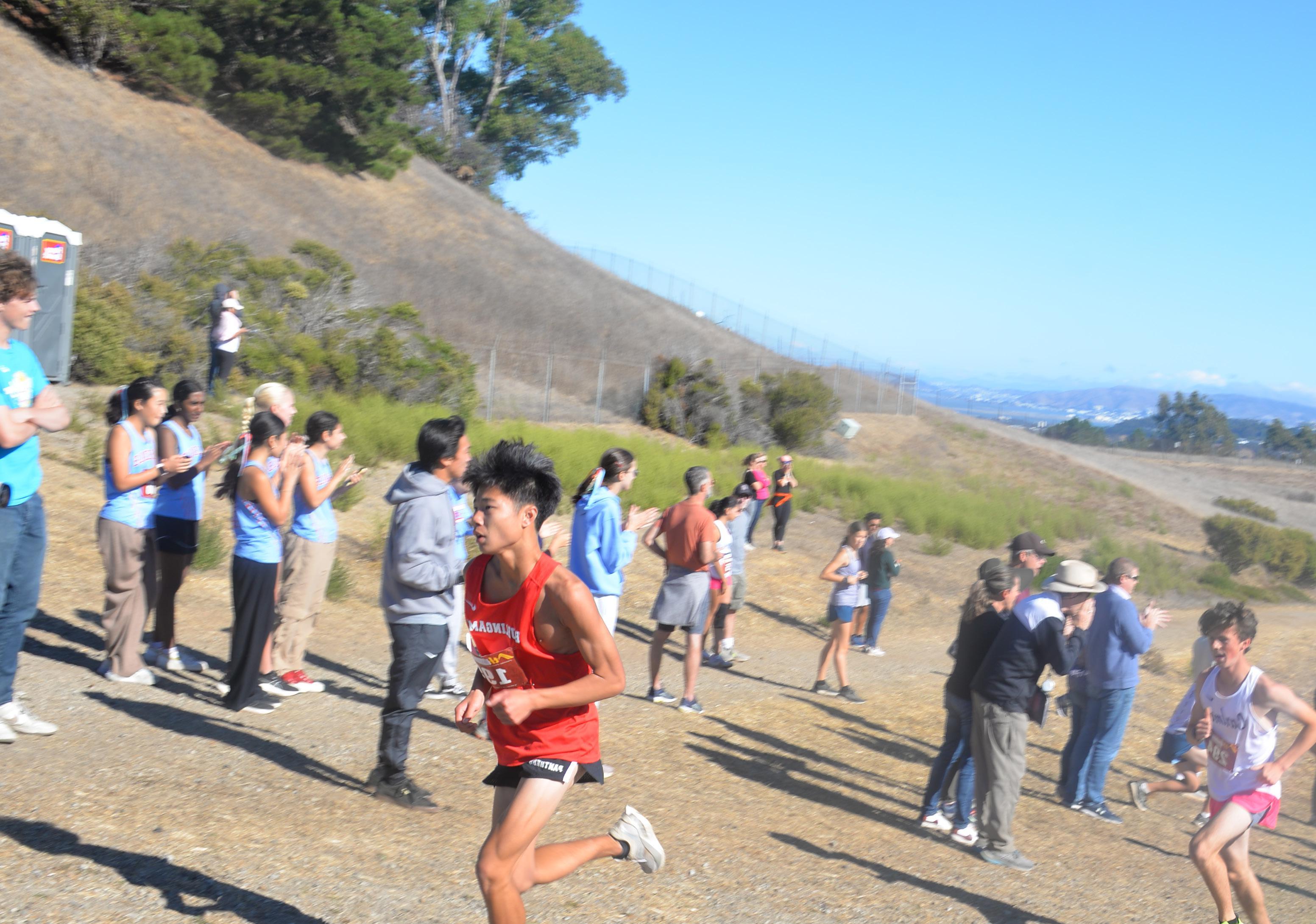
BY JOSIE WETTAN Copy Editor
Cross country is dialed in on returning to CCS, treating every meet this season as training for the competitions that count the most. That hasn’t stopped the Panthers from putting up solid performances—including multiple personal records at the squad’s second PAL meet on Oct. 16. Sophomore Elizabeth Carroll and junior Stella Newman took fourth
and fifth place for the girls. Junior Ryan Liu and sophomore Tad Folgner finished highest for the boys, with Liu taking 26th place. Going forward, the athletes are preparing, and confident, for the PAL Finals on Nov. 9.
“We have all the right people and all the right pieces you need. If everyone is on their best and has a great race, I think we’re going to have no problem qualifying,” Newman said.
Editor-in-Chief Sophia Bella
Managing Editors
Jeannine Chiang
Zachary Newman
Design Editor Joelle Huysmans
Social Media Manager Abby Knight
Web Editor Connie Lu
Multimedia Editor Natalie Gyde
Business Manager Iny Li
Head Photographer Henry Gardner
Diversity Coordinator Evelyn Du
Social Coordinator Kaylee Hwang
Copy Editors
Will Kriner
Sophia Doss
Josie Wettan
Senior Reporters
Alex Bertelli
Audrey Wei
Emma Yu
Staff Reporters
Paige Cornelius
Connor Leong
Akira Nakamura
Olivia Newman
Kai Shah
Chiara Wesley
Abby Zarahn
Teacher Adviser
Melissa Murphy
Policy Statement:
The Burlingame B is a student-run newspaper with the sole purpose of providing an open forum for student expression. Anything printed represents the opinion of the writer, but not necessarily that of the Burlingame B staff, the administration, or the faculty of Burlingame High School, or anyone affiliated with the San Mateo Union High School District. The Burlingame B does not discriminate against race, political orientation, ethnicity, religion, gender, sexual orientation or disability. Although The Burlingame B will never refuse to publish guest submission based on the aforementioned factors, we reserve the right to edit or not publish them.
Letters to the Editor
Disagree with the writers? Bring your letters to the room A120 or email them to <theburlingameb@smuhsd.org>. Letters may be considered for publication. The Burlingame B reserves the right to edit for clarity, length, and accuracy. We welcome all comments.
Website: www.theburlingameb.org
Phone: (650) 558-2899
Email: theburlingameb@gmail.com
Address: 1 Mangini Way, Burlingame, CA 94010
BY THE BURLINGAME B Editorial Board
With the recent death of singer-songwriter and former One Direction member Liam Payne on Oct. 16, we were reminded of how disrespectfully celebrities are often treated after their death. Fans reacted strongly following Payne’s passing, with some flocking to Casa Sur Hotel in Buenos Aires, the site of his death, while others voiced their support on social media. However, a wave of misinformation, offensive jokes, and accusations quickly followed. Social media users spread conspiracy theories, most notably placing blame on his ex-girlfriend, Maya Henry. These theories are disrespectful and insensitive at a time when Henry is likely experiencing great grief.
Celebrities’ constant presence in the spotlight fuels parasocial relationships, creating a lack of privacy as fans obsess over every moment of their lives. While supporting a celebrity isn’t inherently problematic, disregarding the wishes of their families, especially after their passing, crosses a line from admiration to invasion. Fans often feel like they have a genuine connection with these celebrities, believing they are entitled to grieve in a way that often feels invasive to

the families of those who have died.
Unfortunately, Payne’s death isn’t the first time we’ve seen grieving fans cross the line. In 2020, when basketball legend Kobe Bryant died along with his daughter Gianna Bryant and seven others, the internet quickly spread harmful content regarding their passing. Disturbing pictures taken at the crash site, some of which showed Bryant’s body after their fatal helicopter crash, spread online so extensively that it led to future legal action.
The culture and expectations
around celebrities in our society is, in itself, problematic. But by staying mindful of the privacy of these individuals and their families, we can find a more respectful and compassionate way to mourn.
It is, of course, understandable to be upset after losing someone you might consider a role model. But fans do not have the right to place blame, to violate the privacy of the deceased and their families, and to spread hateful rumors and misinformation. Even in death, celebrities like Liam Payne can’t seem to escape the glare of the spotlight.
BY ABBY ZARAHN Staff Reporter
Whether it’s low-quality, poorly made t-shirts or cheap lookalikes of the trendiest tops in Vogue, the drawbacks of fast fashion trends undoubtedly outweigh the benefits. While some styles are here to stay in 2024, fast fashion trends are not only environmentally deteriorating and a huge waste of money, but they also limit authenticity.
Fast fashion trends impact our environment more than most people think. According to Glimpse from the Globe, a University of Southern California online student publication, 92 million tons of textiles go to waste yearly. Because textiles can’t decompose, they pollute our rivers and streams. In a world already fac-
ing all kinds of greenhouse gas and fossil fuel emissions, our wardrobe choices shouldn’t add to the damage we’re doing to the planet. Another issue is the unconscious habit of spending money on cheap duplicates. Ironically, we might be spending more time and money trying to replicate an item than simply purchasing the original. Imagine this: you buy a three-dollar shirt from an online fast fashion store. When it arrives, you’re out the door wearing this new, trendy top. A few wears later, the material starts to break down – the strings start to fray, and the color begins to fade. You throw the shirt away to replace it with a new one. This cycle of constantly buying, discarding, and repurchasing only to throw away again continues to repeat itself without you realizing

The
it. Soon, those three dollars will add up to 30, and maybe even 300 over time. The low per-wear cost is great, but the real cost is the low per-wear amount. So, the next time you’re browsing popular fast fashion sites like SHEIN or TEMU, remember that while affordable clothing can be appealing, it’s probably not worth the cost if you only wear it a few times due to the poor quality. Fashion trends also diminish individual authenticity by stifling originality. Fashion trends tend to take away personal style, making it harder for people to express their unique selves. Although it’s easier to follow trends, being true to yourself is far more rewarding. I notice people change their daily outfit choices and personal style to match the current trends, but by doing so, they limit their self-expression. We need diverse styles to make society exciting, cohesive, and innovative.
But how do we avoid these drawbacks of fast fashion trends? Simple solutions such as shopping at thrift stores and flea markets are easy and environmentally sustainable alternatives to purchasing fast fashion. Buying items already worn but still in good quality for discounted prices is far better than buying cheap, raggedy new clothes.
Fast fashion trends may seem convenient, but they harm the environment, your wallet, and personal authenticity. I recommend staying far away from the deceiving aspects of fast fashion, and thinking twice before you hit “add to cart.”
BY PAIGE CORNELIUS Staff Reporter
With over 100 different academic, cultural, and service clubs across campus, club accountability can be hard to keep track of. To facilitate that task, the leadership class has created new rules to monitor the clubs: according to senior and Associated Student Body (ASB) President Zoe Browdy, as of this fall, mandatory monthly meetings, Google Form updates from club presidents, and club constitutions are required, holding clubs to a much higher standard.
Through a new initiative to foster communication between the leadership class and students, Browdy and the rest of the leadership class found that most clubs weren’t meeting regularly, making it difficult for freshmen and transfer students to get involved.
Another issue for clubs is the substantial drop in engagement between the club fair and the first meetings. Water Safety Club co-president and junior Zadie Tsai experienced this firsthand: despite having over 100 sign-ups at the club fair, her excitement turned into disappointment at her first meeting on Tuesday, Oct. 1 when less than half of the prospective participants showed up.
“At our first meeting, only a very small fraction of the signups actually went, and I think that was partly because there’s a lot of club meetings on Tuesdays, but also a lot of people sign up for clubs and never go to them,” Tsai said.
“There’s really something out there for everyone and you have the opportunity to build your own clubs, whatever your passion or interest is, you can find a club that matches it.”
“Recently we started a BHS_ASB email, which is a student-run email where students can ask questions about anything regarding leadership,” Browdy said. “Once that opened, we got a lot of questions regarding clubs, and how students can get involved.”
- Zoe Browdy, ASB president
Biology teacher Kelsey Fjell-Walton, the faculty advisor for four different clubs, noticed the lack of attendance, especially as the year progressed. She mentioned the struggle of scheduling her clubs to ensure that all groups had time to meet.
“I think it goes back to how many clubs we have because there’s so many … and I face scheduling conflicts like mak-
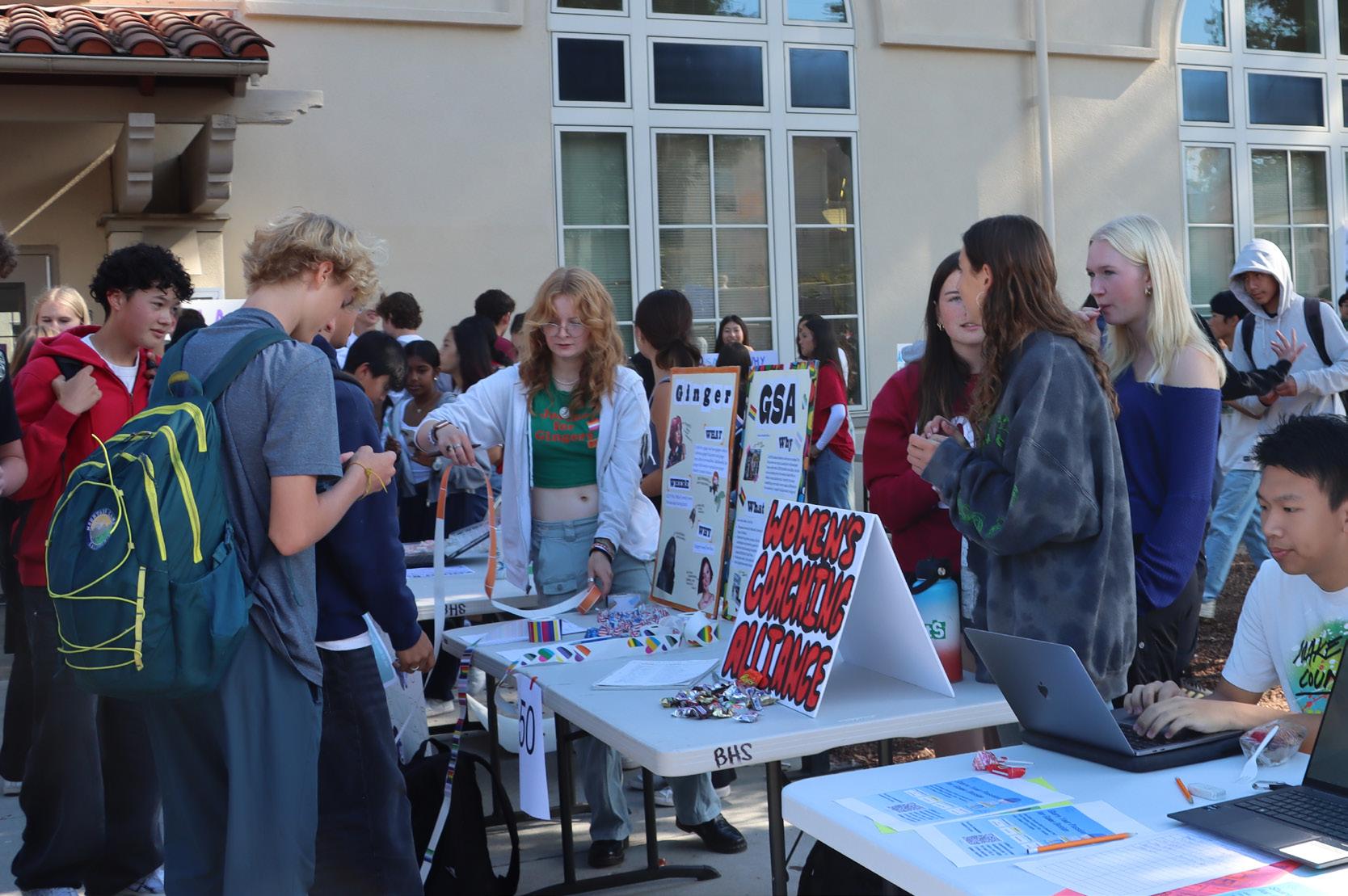
ing sure I don’t have multiple clubs meeting in my room at the same time,” Fjell-Walton said. “And, attendance [trickles] off as finals come around and people get stressed or lose interest.”
National Honor Society and Students in Action member junior Ryan Liu finds it especially difficult to balance his club commitments with his academics.
“I think classes add a lot of pressure and take time away from being really involved in the clubs,” Liu said. “It’s harder to put time into [clubs] when you’re trying to study for finals, and you could use that lunch to
study in the library.”
These absences have affected not only club members but also the broader student body, prompting the enforcement of rules aimed at shifting club culture.
“It has been an issue having over 100 clubs, but only 30-50 would meet regularly, so we just really want to make sure we have clubs that we can count on,” Browdy said.
Fjell-Walton expressed her support for leadership’s changes and their potential to address issues surrounding clubs at Burlingame.
“What’s the point of a club if you’re not meeting regularly?
[If you] put in the effort to start the club, keep that momentum going,” Fjell-Walton said. “The constitution is good too because it really solidifies what this club is standing for.”
Browdy hopes these guidelines will mark a new chapter for clubs at Burlingame.
“The goal of clubs is to uplift students and [allow] people to connect with others who have similar interests, passions, or cultural backgrounds, so putting the standard of meeting monthly in place and streamlining the amount of clubs we have helps people find clubs that are actually meeting,” Browdy said.

BY EVELYN DU Diversity Coordinator
According to the Google Dictionary, death is “the end of the life of a person,” or “the destruction or permanent end of something.” While it is true — death often conjures up feelings of hopelessness, loss, and grief — members of the Mexican and Hispanic communities would find the formal definition lacking. On Día de los Muertos (Day of the Dead), families celebrate and honor loved ones who
happens after we die,” Spanish teacher Eric Vences said. “But in our culture, it's seen as an opportunity to connect and celebrate.”
Burlingame students and teachers alike celebrate Día de los Muertos — some more traditionally, while others to a more moderate degree. Nonetheless, all still stay true to the core values of the holiday: family, remembrance, and celebration. However, the Burlingame community would agree to add one more: reconnection.
“I feel like we sometimes

colorful traditional banners, catrina skull makeup, and vibrant festivals are part of it, but more important is the communal aspect of the celebration.
“We used to go to Guadalajara, Mexico [to celebrate],” Vences said. “My grandma's family is there and they live on a big ranch. Nearby, there was a cemetery that we used to go to, and we would camp out there with food [and] pictures overnight because it lasts a few days. It's a celebration and also a reason to bring the whole family together.”
Junior Sem Cerna Aviles moved to the U.S. when she was three. Unlike the celebration in

“All of my family is in El Salvador… and they're the ones who go out and celebrate,” Cerna Aviles said. “None of our ancestors are buried here, I don't have anyone to mourn, and I don't have any graves to visit. It's that disconnect and distance [that prevents me from celebrating] because I'm not with the people that I should be celebrating.”
Growing up, junior Christopher Spinoso felt a similar disconnect to Día de los Muertos. Nonetheless, his family does their best to stay true to the true spirit of celebration. Every year, Spinoso’s family puts up an ofrenda for his grandmother
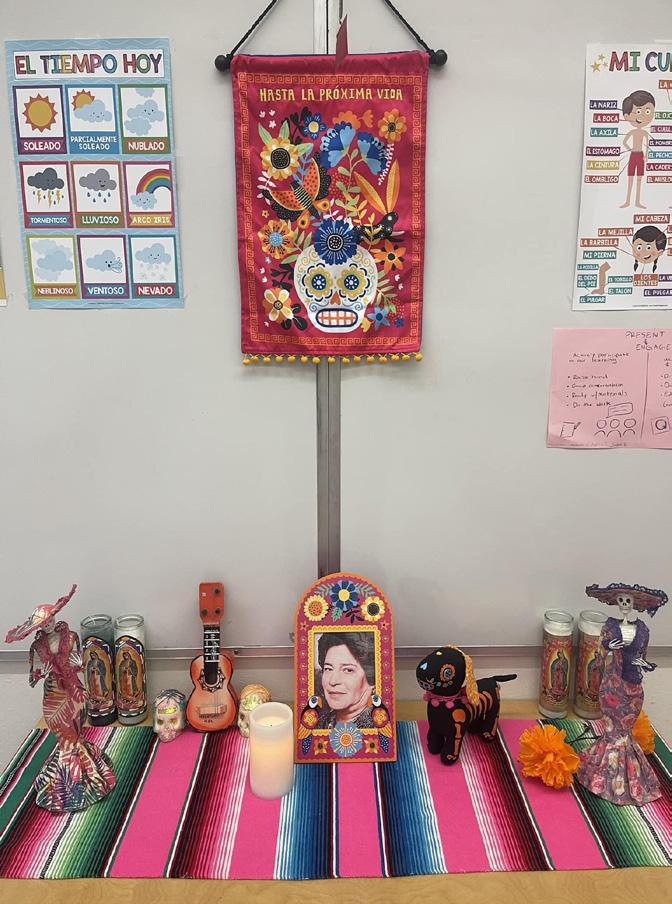
Altars, or las ofrendas (“offerings”) are an important part of the holiday.

BY ALEX BERTELLI Senior Reporter




Something’s been wrong ever since the arrival of 50-Across. The eight starred clues are missing things that need to be re-inserted before solving; if the #th word of the clue is altered, take the #th letter of that resulting clue. Reading these letters in clue order, across and then down, will reveal what eventually came between us and our unwanted visitor.
ACROSS
1. It comes after Alpha
5. Okay
10. Not difficult
14. In brief, Sturdy’s predecessor*
15. What’s been happening to the eight starred clues?
18. Form a knot
19. Possible boolean value
20. Grinding tooth
21. Squirrel’s prize
22. Comical commentary
25. “All the king’s ___”
26. Pastry leftovers
30. Like some potatoes?
31. Intelligent, introverted people, stereotypically
33. ___-Caps (candy)
36. Verge*
37. Has enough courage for
40. Woodwind instrument
41. “It’s hopeless”
45. Get dates by fling*
48. Frequency
50. Our unwanted visitor...
51. It has nearly 5 billion
53. Opera solo
54. Not digitally, to texters
55. “The ___ Runner”
56. Muslim head covering
57. Conceited people
gives me a deeper appreciation of what this celebratory event is now because I get to connect with her more, and talk to her through prayers.”
Over time, Spinoso’s appreciation for the holiday grew. He uses the month of Día de los Muertos to reconnect with his culture and family.
“[My favorite part] is just my family coming together. We're at the dinner table eating as a family,” Spinoso said. "It's that Thanksgiving feeling, you're honoring your ancestors, you're having fun together, eating wonderful food. It's just an amazing experience.”
As a mother, Espinoza Osuna is determined to pass on her family’s cultures and traditions to her children, no matter how far they live from

“I sit down with my boys [because] for me, it’s important to continue passing on the tradition to them,” Espinoza Osuna said.
“Even though they were born here, it's important for them to remember our family, our loved ones, and to recognize everything they



58. ___ and Clark
60. Confess
63. “Show us!”
66. Volcano’s output
68. Least Great Lake?
69. Like an unkempt room
72. Sleep lightly
73. Ale (angrily)*
75. Held closely
78. Huge brass instrument
80. Uranium-235 or uranium-238, for two
81. Like the leg of a person who holes, perhaps*
82. Call of ___ (video game)
83. They might be attacked at parties
84. Collections of objects DOWN
1. Besties, in short
2. Historical period
3. Cheat while using a pinball machine
4. Stomach muscles
5. It comes in amber, silver, and blue varieties
6. One who inhabits a rented living space
7. At a standstill
8. Endocrine organs
9. Old Russian emperors
10. Top-left key
11. Microscopic ‘Lego brick,’ perhaps
12. Man’s formal address
13. Longs (for)
16. Minus sign*
17. Humanoid monsters in Tolkien fiction
23. What many would consider the arrival of 50-Across to be?
24. An 11-Down missing an electron, maybe
27. Game whose name you shout out
28. What was told to some victims of 50-Across...?
29. Smile smugly (in an irritating way)
30. Japanese “yes”
32. What could be used to fend off 50-Across?
34. ___-Wan Kenobi
35. Treatment program for drugs or alcohol
38. Distinctive, spiritual emanations
39. Speaks
42. Aloe ___
43. Good or vile for consumption*
44. Coat, as a canvas
45. Sinister groups
46. Followed closely behind
47. Destiny
49. ___ Mahal
52. Stitch up
56. Groundskeeper of Hogwarts
59. Assorted greens
61. “Ready ___, here I come!”
62. Quick with humor
64. Flightless Australian
bird
65. It sees
66. Flower with spiritual significance
67. Sky blue
70. Garden that is fled in Biblical lore*
71. Thin cut
74. College in Tempe
75. Officer
76. Gene carrier
77. Party musicians
79. Wager
Solve online with answers!
